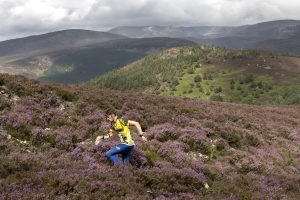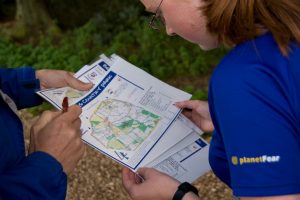Beginners’ Guide
No matter your age, fitness level, or knowledge of orienteering, as a  beginner you’re very welcome at club events. Orienteering activities and events are a great family outdoor activity, great for socialising or keeping fit with friends, for enjoying the outdoors and exploring your local area. Most clubs offer specific activities or events just for beginners. These events help you get to know the basics and increase your confidence.
beginner you’re very welcome at club events. Orienteering activities and events are a great family outdoor activity, great for socialising or keeping fit with friends, for enjoying the outdoors and exploring your local area. Most clubs offer specific activities or events just for beginners. These events help you get to know the basics and increase your confidence.
We know it’s pretty exciting but also can be daunting to turn up to an event, perhaps in a forest or on a hillside, without knowing what to expect. Don’t worry! Have a read below on what usually happens and what you need to bring and read through some of our useful guides.
How to start off
Feel free to turn up to regular club events, listed here. We recommend starting by attending “Local” events (shown in green) or “Activities” (shown in yellow) as they’ll be smaller and there will be somebody on hand to give you guidance. If you don’t see any events listed in your area, or have any questions, please contact your local club. They’ll be able to tell you if any beginners’ events are planned, or which is the most appropriate event to try.
If you’re over 18 and a beginner or returner to orienteering, you might like to try a weekend of expert coaching in basic skills in some of the best terrain in the UK.
What to expect at an event
Most clubs run small, local events which are ideal for newcomers. While you can often enter in advance this isn’t usually required – you can usually just turn up on the day.
 Arriving
Arriving
The club website will usually state when event registration will be open (usually for an hour or two) and the range of start times. As a newcomer it’s a good idea to arrive fairly early. Ideally, travel with someone from your local club, or arrange to meet them there. When you arrive, head towards “Registration”.
Registration
Registration is the ideal place to ask any questions – such as if there’s someone available who can talk you through the basics. Provided you’ve arrived in plenty of time, someone will be happy to help!
You can orienteer on your own or as a family group – just ask at registration and they’ll guide you through the process.
Most clubs require you to fill in a short form giving your name and contact details (if you’re not already a member), Courses will usually be as shown in the colour-coded table, so you just choose which you want to enter. For beginner adults we usually recommend an Orange course, while a White course is an ideal starting point for children.
Experienced orienteers are given their maps at the start but beginners – especially children – usually collect their map at registration to give extra time to understand it before they set off.
You’ll be given an electronic ‘chip’ which manages the timing for you and stores details of the control points as you visit them. Remember to ‘punch’ your chip at the start, at each control and at the finish, to show you’ve been there.
Start-times and route to the start

The setup at the start will depend on the size of the event, and often involves sending people off at intervals of a minute or two. You can find out the starting point, starting process and your starting time from registration.
Download and results
When you’ve finished, go to the table or tent marked ‘Download’ – here you will receive your printout confirming which controls you visited and how long you took for each one. Download will probably be where registration was before your run.
At some events the results will be on display almost as soon as you have finished. For others you might have to wait until the results appear on the club’s website (usually later that day). Don’t worry about your time though – your main aim should be to find the controls and enjoy yourself!
Top tips for starting out
Orienteering takes a bit of practice, and these basic techniques should help you:
- Look at the map legend and see what the different colours refer to.
- Fold the map so you can easily focus on the bit that matters at the time.
- Turn the map so the way you’re going is always straight ahead. You can use a compass for this, or you can do it simply by looking around you. Turn the map each time you turn a corner – this is called keeping your map SET.
- Use your thumb to keep track of where you are as you walk, jog or run. Watch for path junctions and other points to “tick off” as you pass them.
- Focus on getting your navigation accurate and run at a speed which allows you to do that
- The course is marked by straight lines between the control circles but you might use paths that are less direct. If you’re doing an Orange course (or harder), you’ll have some route choices – often a matter of choosing between a longer run along paths or a shorter, more direct route.
- Visit the controls in the order shown. Control descriptions tell you the code of the marker you’ll find, and a brief description of the feature that it’s on. If you find a control with a different code, ignore it, it’s not yours!
- Control descriptions might look confusing, but if you simply navigate to the centre of the circle, you’ll find the marker. There’s a card to help you translate the symbols into English, but you can manage without it!
- Look at the map scale; work out what distance is represented on the ground by a centimetre on the map. How many double-paces will it take you to cover that distance?
- If you’re at an event, always report to DOWNLOAD even if you haven’t completed your course – otherwise the search parties will be sent out to look for you!
If you have any questions, don’t be afraid to ask! Contact us or your club if you have any queries.
Training and learning
 There are many ways your local club and the SOA can help get you started with or improve your orienteering techniques.
There are many ways your local club and the SOA can help get you started with or improve your orienteering techniques.
In-club training
There are trained, qualified coaches within every club across Scotland, to support members to improve techniques. Some clubs host regular training meets; others put on special training events – and if you’re interested, ask your club!
SOA training courses
The SOA also runs a number of different courses for those wanting to improve their orienteering, from beginners to advanced athletes. There are training days or weekends, and we also run courses on request. You can see what courses we have available here, or contact our Education Manager if you don’t find what you’re looking for.
SOA online training resources
As part of our online Resource bank, you’ll find a Beginners and New Members section with a range of downloadable activities to help guide you in specific techniques to improve; you can browse and download them for free. There is no substitute for face-to-face coaching however, so if you’re looking to grasp the basics or to improve, we would definitely recommend one of the above options.
Read our A-Z of orienteering
Like any sport, orienteering has words and phrases you’ll quickly pick up as you start taking part. You can read about these in our A-Z Jargon buster.

 Arriving
Arriving